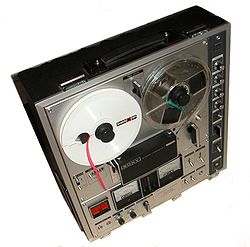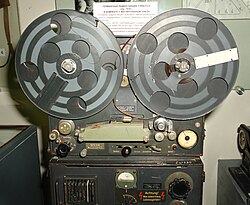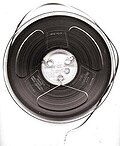Reel-to-reel tape recorders
Reel-to-reel tape recorders (often called R2R, open reel decks, etc.) were used during the 20th century, mostly in professional studios from the 1940s and quickly spread into people’s homes in the 1950s and 1960s. Popularity peaked in the 1970s, probably because people needed higher quality recordings. This technology was like a revolution, because everyone could record any kind of sound (vinyl records, radio broadcast, voice and music), then play it many times without the quality getting worse, and they could overwrite it many times. This technology has some weak points though: size of reels, sensibility, durability; but still, it has certain advantages over today’s “digital media formats.” Also, some famous bands and artists used reel to reel technology as a musical instrument [1] or even as a separate band.[2]
Technical information
These reel to reel decks are usually analogue sound devices using a magnetic tape of ¼ inch (i.e. 6.25 cm) width. This plastic tape is covered by a special magnetic substance which is being made into magnetic domains when it is being recorded. The tape recorder must have a record, playback and an erase head which transfer the signal onto the tape. The more expensive tape decks have three or six separate heads. Tape recorders combine knowledge both on mechanics and electronics. There must be very precise motors and moving parts, but also a complicated circuit board. It has to contain transistors, amplifiers etc.
The usual functions of tape recorders are:
- Playback (play)
- Stop
- Rewind
- Fast forward
- Pause
These functions can be handled mechanically (system of rubber belts and metal levers), or electronically (magnets, coils, integrated circuits).
Tape speed
The tape speed [3] is one of the things that finds out the playback time. This table gives information on tape speed and the playback time with an 18 cm reel.
| Tape speed (cm/s) | Description | Playback time (min) |
|---|---|---|
| 9.52 | Lower, but O.K. quality | 128 |
| 19.05 | Standard-quality home use | 64 |
| 38.10 | Semi-professional or high quality use | 32 |
| 76.20 | Professional studio quality | 16 |
Major producers
There were many producers during the era of tape recorders, such as Sony, Akai, Revox, Teac, Pioneer, Technics, Tesla and many others.[4] These producers usually had several product series', which were different in price and functions. The best ones had digital programmable counters, reverse mechanic, electronic buttons, they could use big reels (such as 26.5 cm). There was also a big selection of tape producers – Maxell,[5] Basf (Emtec), Quantegy, Agfa, etc.
Reel-to-reel tape recorders in Czechoslovakia
There were only a few producers of tape recorders in Czechoslovakia. The most important was Tesla, n.p.[6] The main development was realized in Tesla Pardubice, but the mass production was held in Tesla Přelouč. Product numbers were in thousands pieces and tens of model lines. One of the most popular decks was monophonic Tesla Sonet Duo (1959).[7] It was compact, portable and reliable. The collectors of Tesla decks agree that probably the most progressive model was Tesla B73 Hi-Fi Stereo (1978)[8] which provided the principles to the later models. The supreme models were Tesla B115,[9] B116 (1981) and Tesla CM130,[10] CM160 [11] (1986) which were able to compete with similar models made by world’s producers. Still, there were (political) restrictions, so the best ideas and solutions could not be realized. The manufacture finished in 1990 as this technology turned out to be out-of-date.
Use with computers

In the 1960s and 1970s, tape recorders were used to store programs and data.[12] They record data as a sequence of tones of certain frequency. Nowadays, this method is used only to create backups, because the data rate of magnetic tape is very low.
Reel-to-reel Tape Recorders Media
Magnetophon from a German radio station in World War II.
7-inch reel of 1⁄4-inch-wide (6.4 mm) recording tape, typical of non-professional use in the 1950s–70s. Studios generally used 101⁄2 inch reels on PET film backings.
Astrovox Polaris III reel-to-reel 1960 at Universum in Ciudad Universitaria in Mexico City
"Heavenly" by Johnny Mathis. Produced by Columbia Records (CQ 333). Circa 1959. Recorded for playback at 7.5 ips.
References
- ↑ Emerick, Geoff. Here, There & Everywhere - Geoff Emerick's Life Recording The Beatles. 6. Gotham Book, 2006. 113,139,168,215. Print.
- ↑ http://blog.makezine.com/archive/2008/12/reeltoreel-ensemble.html[dead link]
- ↑ "Analog Tape Recorders." N.p., n.d. Web. 17 Oct 2011. <http://artsites.ucsc.edu/EMS/music/equipment/analog_recorders/analog_recorders.html Archived 2011-10-09 at the Wayback Machine>.
- ↑ "Reel to Reel recorders - audiotools.com". audiotools.com. Archived from the original on 2011-12-22. Retrieved 2011-12-09.
- ↑ "The Maxell Reel To Reel Tape Collection." 28 06 2008. Online Posting to Tapeheads.net. Web. 10 Oct. 2011. <http://www.tapeheads.net/showthread.php?t=286>.
- ↑ Hájek, Martin. "Magnetofony Tesla." Oldradio.cz. N.p., n.d. Web. 8 Oct 2011. <http://oldradio.cz/mgf.htm>.
- ↑ "Magnetofon Tesla Sonet Duo ANP210." Staré stroje. Vilém Mitlöhner, 22 09 2009. Web. 10 Oct. 2011. <http://starestroje.blog.cz/0909/magnetofon-tesla-sonet-duo-anp210 Archived 2009-11-15 at the Wayback Machine>.
- ↑ Mitlöhner, Vilém. "Magnetofon Tesla B73 Hi-Fi stereo." Staré stroje. Vilém Mitlöhner, 12 11 2006. Web. 10 Oct. 2011. <http://starestroje.blog.cz/0611/magnetofon-tesla-b73-hi-fi-stereo Archived 2009-01-23 at the Wayback Machine>.
- ↑ Mitlöhner, Vilém. "Magnetofon Tesla B115 Hi-Fi stereo." Staré stroje. Vilém Mitlöhner, 10 10 2008. Web. 10 Oct. 2011. <http://starestroje.blog.cz/0810/magnetofon-tesla-b115-hi-fi-stereo Archived 2014-05-09 at the Wayback Machine>.
- ↑ "Magnetofon Tesla CM130 Hi-Fi stereo." Staré stroje. Vilém Mitlöhner, 11 07 2010. Web. 8 Oct. 2011. <http://starestroje.blog.cz/1007/magnetofon-tesla-cm130-hi-fi-stereo Archived 2011-02-18 at the Wayback Machine>.
- ↑ "Magnetofon Tesla CM160 Hi-Fi stereo." Staré stroje. Vilém Mitlöhner, 10 03 2008. Web. 10 Oct. 2011. <http://starestroje.blog.cz/0803/tesla-cm160 Archived 2011-03-14 at the Wayback Machine>.
- ↑ http://www.ehow.com/about_5247428_use-magnetic-tape-computers.html








